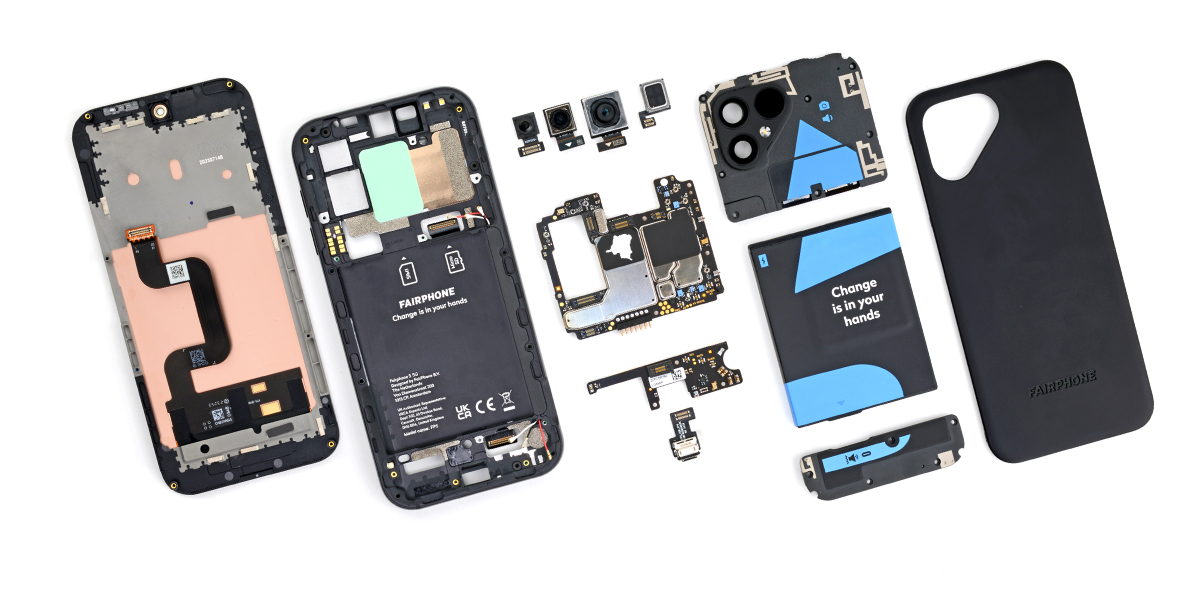“The Fairphone experiment is changing the tech industry.”
That’s what iFixit founder and CEO Kyle Wiens thinks after tracking Fairphone’s journey over the last ten years. Read what he has to say about Fairphone’s transformative impact on the industry, from the Fairphone 1 to the Fairphone 5.
It’s been almost ten years since Fairphone launched an important experiment: If a company built a truly ethical smartphone, would consumers buy it? If it used conflict-free minerals and put the planet first by enabling repair over replacement—would people care?
As the CEO of iFixit and a certified repair nerd, I wanted to believe they would. But once upon a time, I wasn’t so sure. Device longevity, repairability, and the use of fair trade materials simply weren’t priorities for smartphone makers of any size. The newest gadgets were built to be technologically exciting (they often were!), not necessarily sustainable or ethical.
With the recent Fairphone 5—and the growing wave of Right to Repair progress in Europe around the globe—I’ve changed my mind. It is possible. It is already happening. And we’re changing the world.
The e-waste problem remains, but attitudes and policies are changing
One thing hasn’t changed: we’re still facing an electronic waste crisis. Globally, we produce 50 million tonnes of e-waste each year, and are on pace to more than double e-waste by 2050. The 5.3 billion cell phones thrown away in 2022 are a part of that problem.
In the face of these fearsome facts, choosing repair over replacement has begun to go mainstream. The New York Times told consumers that “phone upgrades may be unnecessary because the elements that make us unhappy with our phones can be remedied with some care.” A Wall Street Journal reporter found she could fix her waterlogged laptop at an independent repair shop for less than a third of the cost of a new one. BBC reported on the ways the French are rejecting throwaway culture. Once the domain of the ultra-geeky, repair has become much more broadly appealing, even to the less tech-savvy.
And news stories represent only a snippet of the global groundswell of support for the Right to Repair movement. That sentiment is creating concrete change all around the world.

The fight for ‘Right to Repair’ is everywhere. Image: iFixit
I’m ecstatic that French consumers see a repair index at the point of sale to inform their purchasing decisions. That consumers in four U.S. states will be guaranteed access to the parts, tools and information they need to fix an array of devices, and that the EU passed a law to provide the same for smartphones and tablets by 2025. Additional leaps forward have been taken everywhere, from Quebec to India, Belgium to Taiwan.
All of this progress started with a simple idea: our technology doesn’t have to sacrifice sustainability and human thriving to be innovative and fun. We haven’t solved the problem yet—many devices still house conflict minerals and utilize unrepairable designs. But we’ve taken important steps forward. And each model of the Fairphone has demonstrated that ethical tech is achievable.
A more repairable future starts with a more repairable present
At iFixit, we have spent two decades pushing for a more repairable future. We’ve built the world’s largest repair community, crowdsourcing a catalog of 100,000 free self-repair guides, and advocating for pro-repair policies that have become law in recent years. We also tear down the hottest devices to hit the market, scoring them on their repairability. That includes calling out the best and worst elements of their design—gently encouraging manufacturers to adopt fixable designs.
“When we looked around the electronics industry ten years ago, we were dismayed to see so few electronic products designed to prioritize people and the planet. That got us thinking: if no one else was going to do it, why couldn’t we? That started the whole endeavor.”
Miquel Ballester, Head of Product Development, Fairphone
When the first Fairphone was announced, we noticed. Its modular design and use of fair materials served as a beacon for the way our tech could and should look. It was love at first sight.

The Fairphone 1’s motherboard. Image: iFixit
The Fairphone 1 was an important step in the right direction. But it had some issues. Smaller components including the front-facing camera and headphone jack were soldered to the motherboard, making for pricier replacements. The phone featured many easily-replaced modules but larger components—namely the motherboard and display—contained smaller unreplaceable parts. The assemblies made repairs like fixing a front-facing camera far more expensive than necessary. Hence, the respectable, but less-than-stellar 7/10 repairability score.
We didn’t expect perfection on the first go, but we did hope to see iterative improvements. And to our delight, our hopes were rewarded.
The subsequent model, the Fairphone 2, addressed its predecessor’s problems and achieved the very first 10/10 score we ever awarded to a smartphone.
Fair warning: That perfect score did not mean that the Fairphone 2 was a perfect phone. Users complained of cracks in the case despite not dropping their device. Components were so easy to pop out that dust was able to work its way into the connections, leading to screen glitches and distracting pixel coloration.
These teething pains aren’t unexpected from a new manufacturer, especially one prioritizing access. And Fairphone’s commitment to making a device that could last a decade has been demonstrated with each new version and their 10/10 repair scores. They continued to tinker with the design and makeup of their smartphones, blazing the path to a truly fixable and ethical smartphone.
The Fairphone 5 shows how far we have come
The Fairphone 5 is pretty darn close to that mark. It earned yet another 10/10 repairability score and an IP55 rating, meaning the internals are protected from the harmful ingress of dust and water jets. That’s a slight improvement over the Fairphone 4, which touted a slightly-less-water-resistant IP54 rating. The shiny new OLED screen and beefed-up cameras show that sustainable tech can be sexy, too.

The Fairphone 5 looks GOOD all torn down. Image: iFixit
Now, hardware is only viable for as long as you have software and security updates. For even the most diehard fixer, it can be tough to hold onto buggy and cyber-insecure devices.
“We’re committed to taking a holistic approach to producing a truly sustainable phone. That means producing a phone that is fair to people and planet. This entails four key areas for us; device longevity, sourcing of fair materials, ensuring fair working conditions at the factories, and electronic waste neutrality. Repairability is a key part of device longevity, along with ensuring long windows for software and hardware support.”
Monique Lempers, Chief Impact Officer, Fairphone
That’s what makes Fairphone’s software support promise so important. They’re guaranteeing five Android version upgrades and 8 to 10 years of security updates. The Fairphone 5 you buy today could serve you well into the 2030s.
The ethical smartphone experiment is working
If I could hop in a time machine and talk to my 2014 self, I’m not sure whether he would believe how much has changed. Fairphone is making long-lasting and ethical devices, possibly inspiring market leaders and even laptop makers to follow in their footsteps. People around the world are demanding the Right to Repair, and policymakers are listening.
Mitigating the growing e-waste crisis will only be possible if we continue to build on these trends. Hopefully 2034 me will have more good news to report back.
iFixit is a global community of people helping each other repair things, spurred into existence when Kyle, the author of this piece, couldn’t find a repair manual for his Apple iBook G3 back in 2003. They also consistently perform tear-downs of electronic devices, ranking their repairability. Read more about their mission here.



